Table of contents
- Charging on a motorcycle The turbo comes back?
- Catchphrase “Downsizing”
- It’s about compact and light engines
- Compressor or turbo?
- Performance chart
- The early turbo motorcycles
- Honda CX 500/650 Turbo
- Kawasaki Z 750 Turbo
- Suzuki XN 85
- Yamaha XJ 650 Turbo
- Interview with Norbert Klauer
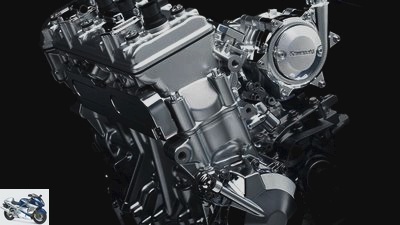
Kawasaki




12th pictures
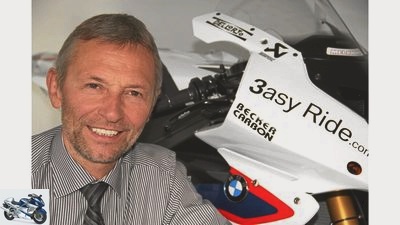
BMW
1/12
Norbert Klauer (58), Head of Powertrain Development at BMW Motorrad, on the possibilities and difficulties of the compressor motor: “The advantages of a compressor are its more direct response, simple exhaust gas routing and greater freedom in terms of functional arrangement. The disadvantages are – at least when no coupling is interposed – because of the continuous drag power with higher consumption. And also in terms of noise.”

fact
2/12
When it comes to responsiveness or package, the compressor has
(a Roots compressor with slip clutch on a Ducati Monster) clear advantages.

www.jkuenstle.de
3/12
Turbocharger or compressor: As far as the fuel-saving potential is concerned, the turbo is clearly ahead, because the exhaust gas energy that drives it would otherwise go unused.

Jahn
4/12
Bucket wheels with a diameter of only 38 millimeters, speeds of up to 210,000 rpm – the XJ 650 Turbo’s supercharger turned out to be extremely small, but the response of the engine for a turbo engine was extremely direct.
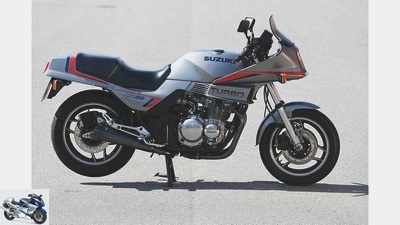
Jahn
5/12
Suzuki only jumped on the turbo train in 1983 and therefore relatively late. And quite subdued. 85 hp instead of 73 – the increase in performance of the GS 650 Katana engine was clear, although Suzuki used a relatively large charger.
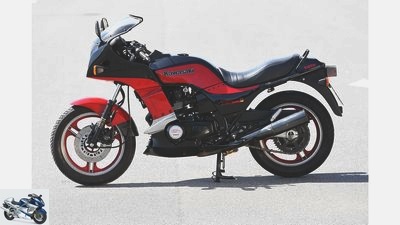
Jahn
6/12
Actually, it was the cylinder head of the Kawasaki Z 650 that was responsible for switching the gas in the Z 750 Turbo. Smaller valves, narrower ducts – this was ideally suited for the heat dissipation of the hot GPZ 750-based turbo project.
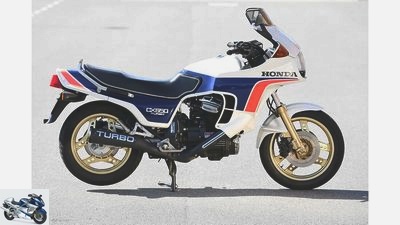
Jahn
7/12
An ideal basis for a turbo project – that was the opinion of the Honda engineers in the early 80s in view of the water-cooled four-valve V2 of the CX 500 and had a supercharger specially designed for this small displacement developed by the supplier Nippon Denso.
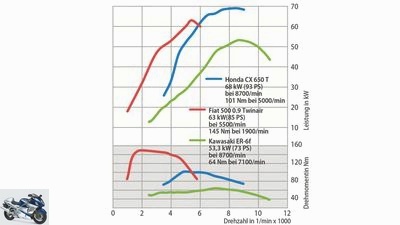
BILLION
8/12
Just as an example to show what is possible: The red curves trace the power and torque curve of the Fiat 500 0.9 Twinair engine, an 875 cubic centimeter two-cylinder gasoline engine with turbocharger.
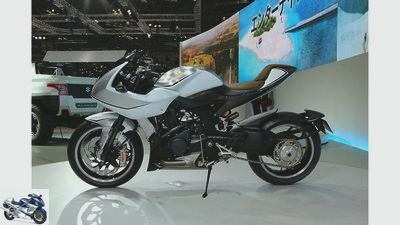
Tokyo Motor Show
9/12
As you can see, you see nothing. Only the pipe between the manifold and the airbox indicates the Suzuki Recursion’s turbocharger.
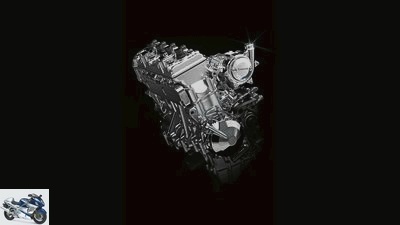
Kawasaki
10/12
Much uncertain: Kawasaki does not even disclose the displacement of the supercharged engine. One speculates with around 1000 cubic centimeters.
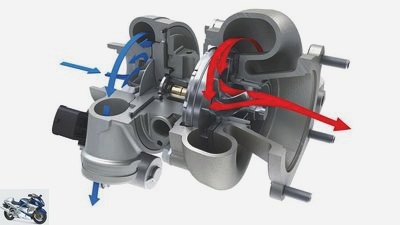
Porsche
11/12
Turbo – the sound of this one little word rushes through the motorcycle community like thunder. Turbo! There was something? We think of Fritz W. Egli and his spectacular MRD 1 from 1979, of the sledgehammer kick-off of a Porsche 911 where nothing comes first, then everything.
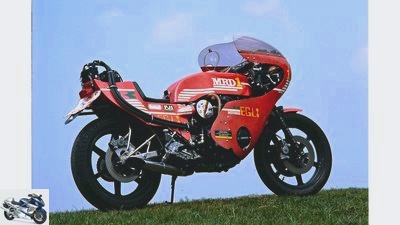
Schwab
12/12
The main thing is pressure: when Fritz W. Egli built his MRD 1, downsizing was not yet an issue. There were rumors of 180 hp and almost 300 km / h.
counselor
workshop
Turbo on a motorcycle
Charging on a motorcycle
The turbo comes back?
Will the turbo come back, does the compressor have a future? One can speculate since the Tokyo Motor Show. Around 30 years after the first turbo era, Suzuki presented the recursion with a 600 turbo twin-cylinder, while Kawasaki presented a supercharged inline quad. All just hot air?
Stefan Kaschel
01/30/2014
You’re keeping a low profile, both of you. Kawasaki even more decisive than Suzuki, where at least the key data of the “Recursion” project are announced. 600 series two-valve twin, 100 HP, 270 degree crank pin offset. An in-line engine with a V attitude, but that’s no longer a sensation after the Yamaha MT-09 and MT-07. The sensation of the recursion is hidden somewhere, invisible between the cylinder bank and the fairing keel. The sensation is the turbocharger.
Buy complete article
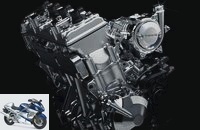
Charging on a motorcycle
The turbo comes back?
6 pages) as PDF
€ 2.00
Buy now
Turbo – the sound of this one little word rushes through the motorcycle community like thunder. Turbo! There was something? We think of Fritz W. Egli and his spectacular MRD 1 from 1979, of the sledgehammer kick-off of a Porsche 911 where nothing comes first, then everything. Maybe, maybe we still think of the failed series turbo experiments of the Japanese in the early 80s. We don’t think about saving fuel.
Catchphrase “Downsizing”
It might be time to rethink. The automotive sector has long shown that the turbo can also be about completely different things. “Downsizing” – the buzzword is on everyone’s lips. Turbocharged engines can be found in almost every engine compartment. Or does anyone really believe that the new 225 diesel from BMW has a larger displacement than its little 218 brother? Both have a four-wheeler with 1995 cubic centimeters under the hood. The fact that this can result in 143, but also 218 HP, is in principle due to only one manipulated variable, namely the boost pressure supplied by the turbocharger.
So is the turbo the panacea with which both power can be generated and consumption can be minimized? In principle yes, because a smaller engine with fewer cylinders also has less internal friction. That saves fuel. Much more important, however, is that due to the early and constant maximum torque, an engine designed in this way can be consistently moved in the low speed range and thus in the ideal load range by upshifting early. The result: consumption drops significantly.
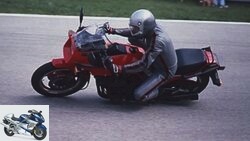
classic
Cult bike: Kawasaki Z 750 Turbo
The last of its kind
read more
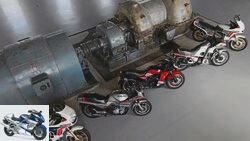
classic
Honda CX 500/650 Turbo, Kawasaki Z 750 Turbo, Suzuki XN 85 and Yamaha XJ 650 Turbo in the test
The big turbo comparison
read more
It’s about compact and light engines
But, hand on heart: Is the motorcycle primarily about consumption? So far, probably not, because the manufacturers neither have to worry about any kind of fleet consumption, nor does an occasional tour of the house make undue holes in the budget. The fact that the turbo still lures in a motorcycle is due to two other things: the compact dimensions and the supposedly lower weight of the turbocharged engines. And that is exactly the approach of the Suzuki Recursion. A 600 in-line twin with the torque output of a 1000; At least that is how it can be inferred from the sparse information on this project. Plus 100 hp, a more than debatable figure for a mid-range motorcycle. The whole thing is to be achieved with very moderate boost pressure (Suzuki does not provide exact values), in which the fresh gas is pressed into the combustion chambers through just one inlet valve per cylinder. According to the Suzuki technicians, the small valve cross-section of the individual valve is sufficient, even with the low boost pressure, to achieve the desired performance and torque values.
So it’s no wonder that in this case the compact design of the two-valve engine in the cylinder head area is also taken with you. And there is another advantage with this special Suzuki downsizing constellation: thanks to the relatively low peak power of 100 hp, the charger size can also be correspondingly small. A charge air cooler, which cools the compressed air, which is heated up to 150 degrees, could probably be dispensed with. In a small supercharger with smaller cross-sections, the flow speed of the exhaust gases at the turbine is also higher even at a low engine speed. The result: the compressor on the other side of the shaft already delivers the corresponding boost pressure in the lower speed range.
Compressor or turbo?
The problems with the poor response of the turbo engine and the sudden use of power in the lower speed range can be avoided, according to Suzuki, while a bypass or wastegate valve at the other end of the speed range releases the excess exhaust pressure into the open. In addition, compared to the first turbo era, there is a completely different engine periphery with modern injection systems and electronically controlled throttle valves, which allow much finer tuning. Nowadays, thanks to knock sensors, higher compression rates could be achieved, while new, more heat-resistant materials from turbo technology would also open up new possibilities in gasoline engines.
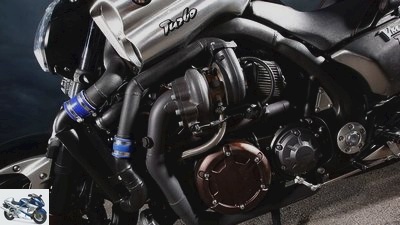
jkuenstle.de
Turbocharger or compressor: As far as the fuel-saving potential is concerned, the turbo is clearly ahead, because the exhaust gas energy that drives it would otherwise go unused.
This could perhaps also mean the use of a so-called VTG charger with variable turbine geometry, with the help of which the responsiveness of the charger is improved when the gas throughput is low. A conceivable, but expensive option, because the VTG charger, which is widely used in diesel cars today, has to use particularly heat-resistant, but also particularly expensive alloys because of the significantly higher exhaust gas temperatures in gasoline engines (around 1100 degrees instead of the 850 degrees usual for diesel). And there are also modern assistance systems such as traction control, which could intervene to regulate the sudden use of power.
“That’s right, but none of it is enough,” says Norbert Klauer, who heads drive development at BMW Motorrad. At least not if you want to use the undoubtedly existing turbo potential to the full and not, like Suzuki, have something like a basic turbo in mind. Then a lot of complex, heavy and extensive technology is necessary. The bottom line is probably too much.
So do you prefer a compressor? Is Kawasaki’s approach more promising? At least he’s completely different. A powerful, supercharged engine in a really powerful motorcycle. At least that’s what patent drawings show that show the supercharged motor in a ZZR 1400 speed bike. But: The Horex example shows that even with this relatively simple mechanical structure, adaptation is not that easy despite all the electronic aids. There they planned full-bodied with the mechanical supercharging, but the six-cylinder still has to suck today.
Performance chart
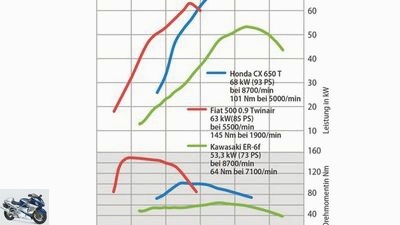
BILLION
The performance curves of Honda, Fiat and Kawasaki.
Just as an example to show what is possible: The red curves trace the power and torque curve of the Fiat 500 0.9 Twinair engine, an 875 cubic centimeter two-cylinder gasoline engine with turbocharger. This engine is trimmed to the earliest possible torque by means of supercharging and builds it up astonishingly early, but also shockingly violently. Of course, no one needs such a sudden increase in torque in a mid-range motorcycle, but it is precisely this mega-early torque maximum that ultimately allows an early upshift – namely around 2000 rpm – and thus the reduced fuel consumption that is so important in the car.
Things are different in a motorcycle. And the performance curve of the 30-year-old CX 650 Turbo shows what potential a turbo engine basically has beyond consumption optimization. Both torque and power are clearly above the values of a current Kawasaki ER-6f, the increase in power is nowhere near as steep and violent. However, the usable performance sets in quite late, the turning ability is limited. And the early turbos were by no means one thing, namely fuel-savers. On the contrary: they drank like the holes.
The early turbo motorcycles
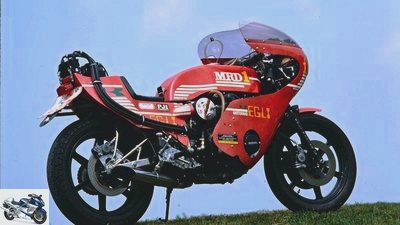
Schwab
The main thing is pressure: when Fritz W. Egli built his MRD 1, downsizing was not yet an issue. There were rumors of 180 hp and almost 300 km / h.
Honda CX 500/650 Turbo
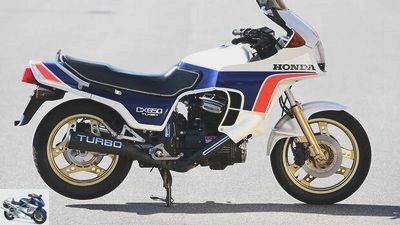
Jahn
The Honda CX 500/650 Turbo.
An ideal basis for a turbo project – that was the opinion of the Honda engineers in the early 80s in view of the water-cooled four-valve V2 of the CX 500 and had a supercharger specially designed for this small displacement developed by the supplier Nippon Denso.
40 millimeter large paddle wheels, up to 180,000 rpm, 1.2 bar boost pressure, 79 Nm torque, 82 hp, 200 km / h: These are the data for the CX 500 Turbo, which was sold in 1982 for 13,203 marks, and exactly 379 times. Just a year later, Honda followed suit and presented the supercharged 650 CX. 100 hp, 103 Newton meters at 4500 rpm – that is certainly not far from the performance data of the Suzuki Recursion. The CX 650 Turbo was sold 56 times at the time.
Kawasaki Z 750 Turbo
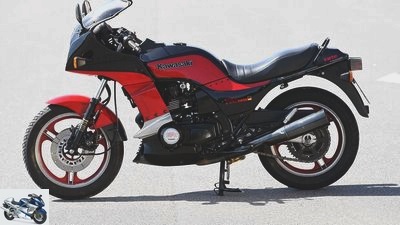
Jahn
The Kawasaki Z 750 Turbo.
Actually it was the cylinder head of the Kawasaki Z 650 that was in the Z 750 Turbo was responsible for the gas switch. Smaller valves, narrower ducts – this was ideally suited for the heat dissipation of the hot turbo project based on GPZ 750. In addition, there were pistons with flatter bottoms and greater wall thickness (compression instead of 9.5: 1 only 7.8: 1) as well as reinforced connecting rods and a more massive crankshaft that were supposed to withstand the raw forces.
Whereby: The forces weren’t really raw, because the high-revving Hitachi charger (200,000 rpm) only produced 0.73 bar of boost pressure; The result was an increase of 26 HP (113 to 87), of which only 100 HP remained in Germany, and a maximum torque of 99 Newton meters, which was applied at 6500 rpm. Worldwide, the Z 750 Turbo was the best-selling turbo motorcycle with 1502 machines.
Suzuki XN 85
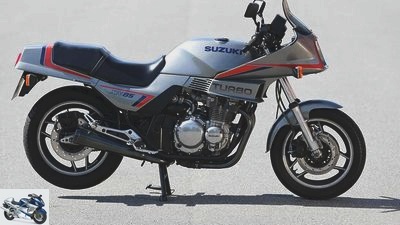
Jahn
The Suzuki XN 85.
Suzuki only jumped on the turbo train in 1983 and therefore relatively late. And quite subdued. 85 hp instead of 73 – the increase in performance of the GS 650 Katana engine was clear, although Suzuki used a relatively large charger. However, it was only allowed to rotate at 140,000 rpm. Probably also because he would otherwise have had to struggle with thermal problems in the slipstream of the cylinder bank.
Despite the manageable boost pressure of 0.73 bar, Suzuki reduced the compression to 7.4: 1 and strengthened the special, nitrite-hardened crank pins on the crankshaft from 34 to 36 millimeters. The pistons were also adapted to the requirements and sprayed with cooling oil via four nozzles each, and an additional oil cooler was installed in front of the cylinder head. Of the XN 85, which is extremely rare today, only 1153 pieces were sold worldwide. It was not officially offered in Germany.
Yamaha XJ 650 Turbo
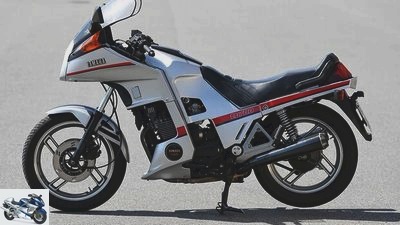
Jahn
The Yamaha XJ 650 Turbo.
Bucket wheels with a diameter of only 38 millimeters, speeds of up to 210,000 rpm – the XJ 650 Turbo’s supercharger turned out to be extremely small, but the engine’s response for a turbo engine was extremely direct. The only slightly reduced compression also contributed to the harmonious power development of the XJ, which incidentally was the only one in the field presented here to rely on carburettors and was sold 315 times.
8.5: 1 instead of 9.2: 1 – this is not the world. The four-in-line pushed off from surprisingly low speeds. At the top, the turbo engine increased from 71 to 90 hp compared to the 650 base, but still hardly achieved better performance, because the weight of the XJ 650 Turbo was also extremely high at 262 kilograms.
Interview with Norbert Klauer
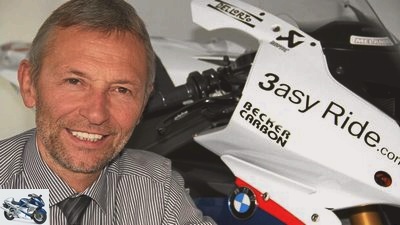
BMW
Norbert Klauer (58), Head of Powertrain Development at BMW Motorrad, on the possibilities and difficulties of modern turbo technology in motorcycles.
Small, compact engines, low weight, rich torque: If a turbocharged mid-range engine with 600 to 800 cubic meters weren’t the ideal all-round motorcycle drive for many models?
Klauer: Drivability with a direct response and precise control over the widest possible speed range is an important goal in the development of our motorcycles. The characteristics, however, depending on whether it is a motorcycle in the supersport sector or a touring motorcycle, are very different. The full range of our offer cannot be satisfactorily covered with a single charged engine. That is why we at BMW Motorrad develop the optimal drive for every segment.
In the passenger car sector, the subject of “downsizing” has become indispensable, especially with regard to fuel consumption and emissions. What role does this topic play in motorcycle development?
Klauer: BMW has a lot of experience with supercharging engines. We have been using TwinPower turbo technology in cars for years and have been able to impressively reduce fleet consumption. Fuel consumption and emissions are also very important to BMW Motorrad. However, the results of the discussion of the high-speed concept versus supercharging and thus downsizing and downspeeding, which took place in the passenger car sector around ten years ago, are not applicable to the motorcycle sector, or if at all, only applicable in certain segments.
Can you get the old weak points of the turbo, i.e. response behavior and power delivery, under control with modern technology? Which charger technology – for example VTG or electrical assistance – is most promising when used in a motorcycle?
Klauer: Our TwinPower turbo engines impressively show the progress this technology has made in recent years. Here, however, not only the charger itself, but all engine components relevant to the mixture and gas exchange, such as high-pressure injection, air ducting, valve train variability and exhaust system, are decisive for success. The choice of charger technology is not the only determining factor in this complex environment. With regard to the motorcycle, the temperature resistance of the VTG and the electrical support the battery and thus the weight pose greater challenges.
Which engine components have to be modified or designed differently for turbo use? Where are the greatest difficulties?
Klauer: In order to meet the requirements of a turbo engine for direct response behavior and favorable fuel consumption with high output, direct injection combined with valve train variability is an essential requirement. This is the only way to achieve high compression and thus good fuel consumption through better internal cooling. This variability in the valve train and intelligent functions of modern engine controls can then significantly shorten the build-up of boost pressure. The direct, immediate response behavior of today’s BMW high-performance motorcycles, the exact precision and controllability over a wide speed range will be difficult to achieve with all the technology. The significantly higher cylinder pressures associated with turbo engines also require a complete overhaul of the entire engine and transmission mechanics.
What is the percentage weight advantage of a downsized turbo compared to a correspondingly powerful naturally aspirated engine with a larger displacement??
Klauer: The reduction in displacement is unfortunately offset by a weight-increasing redesign of the entire engine and transmission mechanics due to the higher cylinder pressures. In order to be able to use the full thermodynamic potential of a supercharger, it is also necessary to create the boundary conditions with regard to gas exchange and mixture preparation, for example direct injection with injector and high-pressure pump, charge air cooling, variability in the valve train. The possible percentage weight reduction is thus even smaller for the smaller-volume motorcycle engine than for the larger-capacity car engine.
Existing components from the automotive sector could also be used in the motorcycle-
use sector?
Klauer: Transferability is possible in principle. Due to the completely different performance characteristics compared to the passenger car, the lower vehicle weight and the larger engine speed range, however, significant adjustments are necessary, which tend to call into question a common part concept.
Can traction control, ride-by-wire, automated transmissions and modern injection technology support the use of turbo?
Klauer: Ride-by-wire and traction control have been in series production at BMW Motorrad for several years and could be transferred immediately. From our point of view, however, intelligent engine control functions are a mandatory prerequisite for successful turbo use. They first have to be developed for the motorcycle engine. An automated gearbox harmonizes well with a supercharged engine, the combination with a standard motorcycle manual gearbox is certainly a bigger challenge with the turbo.
A modern turbo engine with its typical, extremely torque-oriented performance characteristics in a motorcycle would be even conceivable?
Klauer: Extremely high torque can be very attractive in certain segments. In the cruiser segment, for example, relaxed and “shift-lazy” driving is made possible. One of the reasons for the preference for large-displacement naturally aspirated engines is that they start in the very low speed range. Unfortunately, the downsized turbo engine has its weakness here, where there is not yet sufficient boost pressure available.
Would the compressor be a better solution? What are the advantages and where are the disadvantages??
Klauer: The advantages of a compressor are its more direct response, simple exhaust gas routing and greater freedom in terms of functional arrangement. The disadvantages are – at least when no coupling is interposed – because of the continuous drag power with higher consumption. And also in terms of noise.
Related articles
-
Second-hand advice on turbo motorcycles
counselor Used purchase Second-hand advice on turbo motorcycles Second-hand advice on turbo motorcycles Company hot air The heated start to…
-
Motorcycle safety yesterday and today
Security campaign Consideration has right of way Arnold Debus Motorcycle safety yesterday and today Motorcycle safety yesterday and today lead by…
-
Motorcycle production, part 1: Honda
Jahn 15th pictures Jahn 1/15 How are motorcycles produced? Where do the parts come from, what happens before final assembly? These questions urged…
-
Yamaha patent for three-cylinder turbo
Yamaha Europe 5 pictures Yamaha Europe 1/5 Yamaha MT-Turbo? Visually, the experimental engine seems to be planted in the chassis of an MT; the thick…
-
Schwab Sports & scene History of motorcycle tuning History of motorcycle tuning Tuners have never had it harder Content of About 50 years ago, motorcycle…
-
Driving report Neckarsulm motorcycle from 1902
motorcycles Driving report Neckarsulm motorcycle from 1902 Driving report Neckarsulm motorcycle from 1902 At the origin 1901 and 1903 – the beginning of…
-
The small ABC of motorcycle types, part 3 K ?? Y
Yamaha motorcycles The small ABC of motorcycle types, part 3 K ?? Y The small ABC of motorcycle types, part 3 K ?? Y No X in front of a U Why are Z, X…
-
The coolest lady gang in the world – Litas Women’s Motorcycle Club
James Cheadle Sports & scene Motorsport The coolest lady gang in the world – Litas Women’s Motorcycle Club The coolest lady gang in the world – Litas…
-
Honda NC 700 S in the test: the entry-level motorcycle from Honda
Artist 12th pictures Honda 1/12 Honda NC 700 S – The naked bike is powered by an in-line two-cylinder engine of 670 cubic meters. Honda 2/12 Honda NC 700…
-
Japan – a motorcycle manufacturing nation
MOTORCYCLE 15th pictures MOTORCYCLE 1/15 Japan’s motorcycle builder Honda 2/15 Like on the assembly line? In Japan – as here at Honda with the Africa…